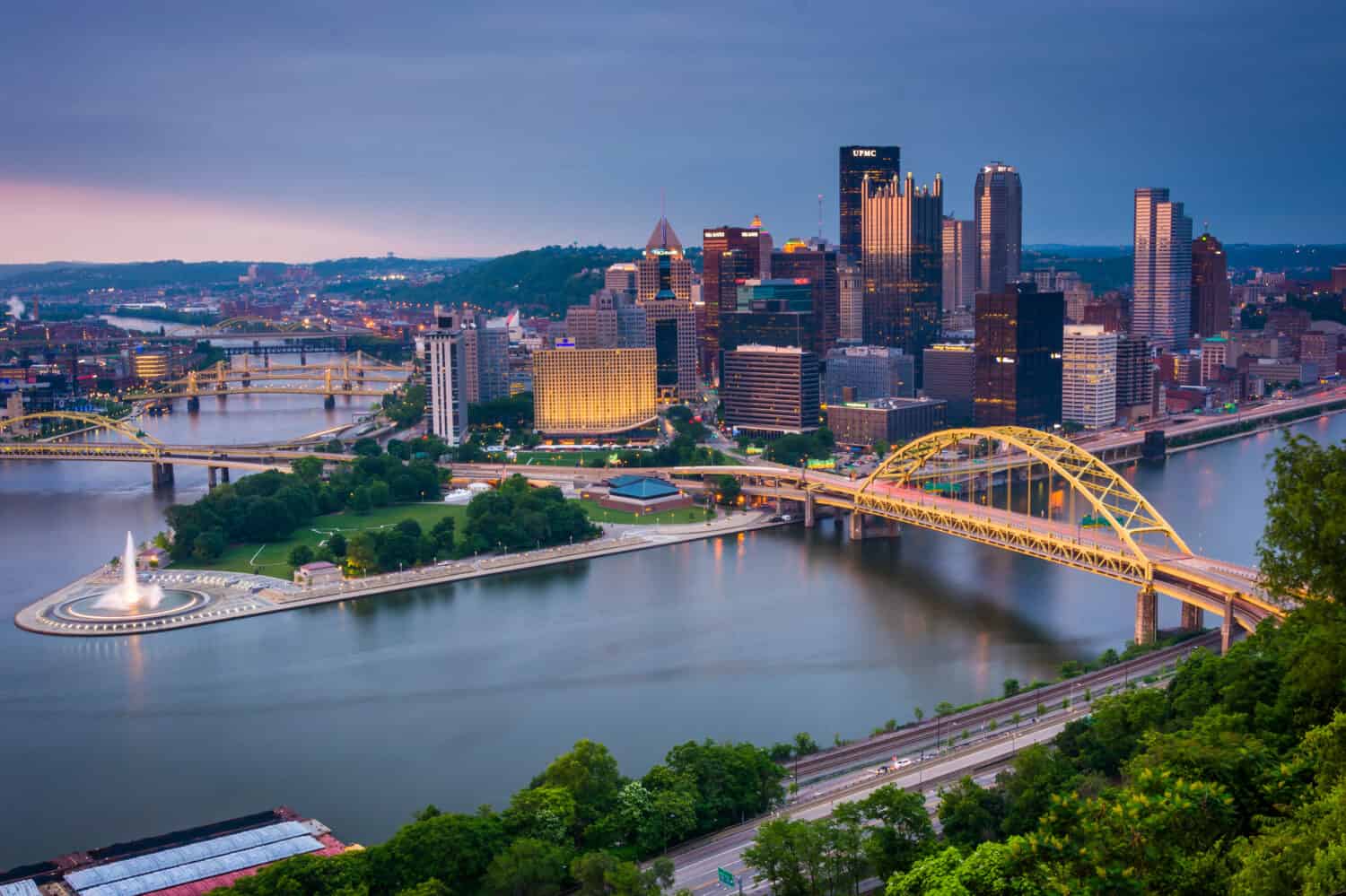Pittsburgh, PA, has an ideal location, surrounded by rivers and other natural resources. All of it aided the city’s historical significance, economic prominence, and cultural variety. Today, the town thrives as a center for education, healthcare, technology, and the arts, attracting visitors and new residents alike to enjoy its unique blend of history, innovation, and scenic beauty within Pennsylvania’s heart.
Learn Facts About Pittsburgh

Pittsburgh’s bridges are a heritage of the steel industry era.
©Trucker from Pittsburgh/Shutterstock.com
- The city is often called the “Steel City” or “Iron City” due to its historic steel and iron industry.
- Charles Martin Hall developed the first commercially successful aluminum production in Pittsburgh in 1888.
- Pittsburgh was named after William Pitt the Elder, a British Prime Minister in the 18th century.
- Three rivers converge in Pittsburgh: the Allegheny, Monongahela, and Ohio Rivers.
- The city played a significant role in the American Revolution and the Whiskey Rebellion.
- The University of Pittsburgh and Carnegie Mellon University are among the prominent educational institutions in the city.
- Pittsburgh is known for its numerous bridges, with 446 in the metropolitan area, earning it the nickname “City of Bridges.”
- Like the Duquesne Incline and. Monongahela Incline, the inclines are historic funicular railways still operating today.
Where Is Pittsburgh Located on the Map?
Pittsburgh is approximately 200 miles (320 kilometers) west of the state capital, Harrisburg. The city is near the state’s western border with Ohio and Western Virginia and the southern border with Maryland.
How Far Is Pittsburgh From Other Major Cities in Pennsylvania?
In the western corner of Pennsylvania, in Allegheny County, Pittsburgh is isolated from other major cities in the state.
| Pennsylvania’s Ten Largest Cities (Pittsburgh is 2nd) | Driving distance from Pittsburgh (miles) | Flying distance from Pittsburgh (miles) |
|---|---|---|
| Philadelphia (1st) | 304 | 257 |
| Allentown (3rd) | 284 | 238 |
| Reading (4th) | 261 | 215 |
| Erie (5th) | 128 | 117 |
| Upper Darby (6th) | 301 | 251 |
| Scranton (7th) | 283 | 235 |
| Bethlehem (8th) | 290 | 244 |
| Lancaster (9th) | 238 | 197 |
| Harrisburg (10th) | 204 | 164 |
How Many People Live in Pittsburgh?
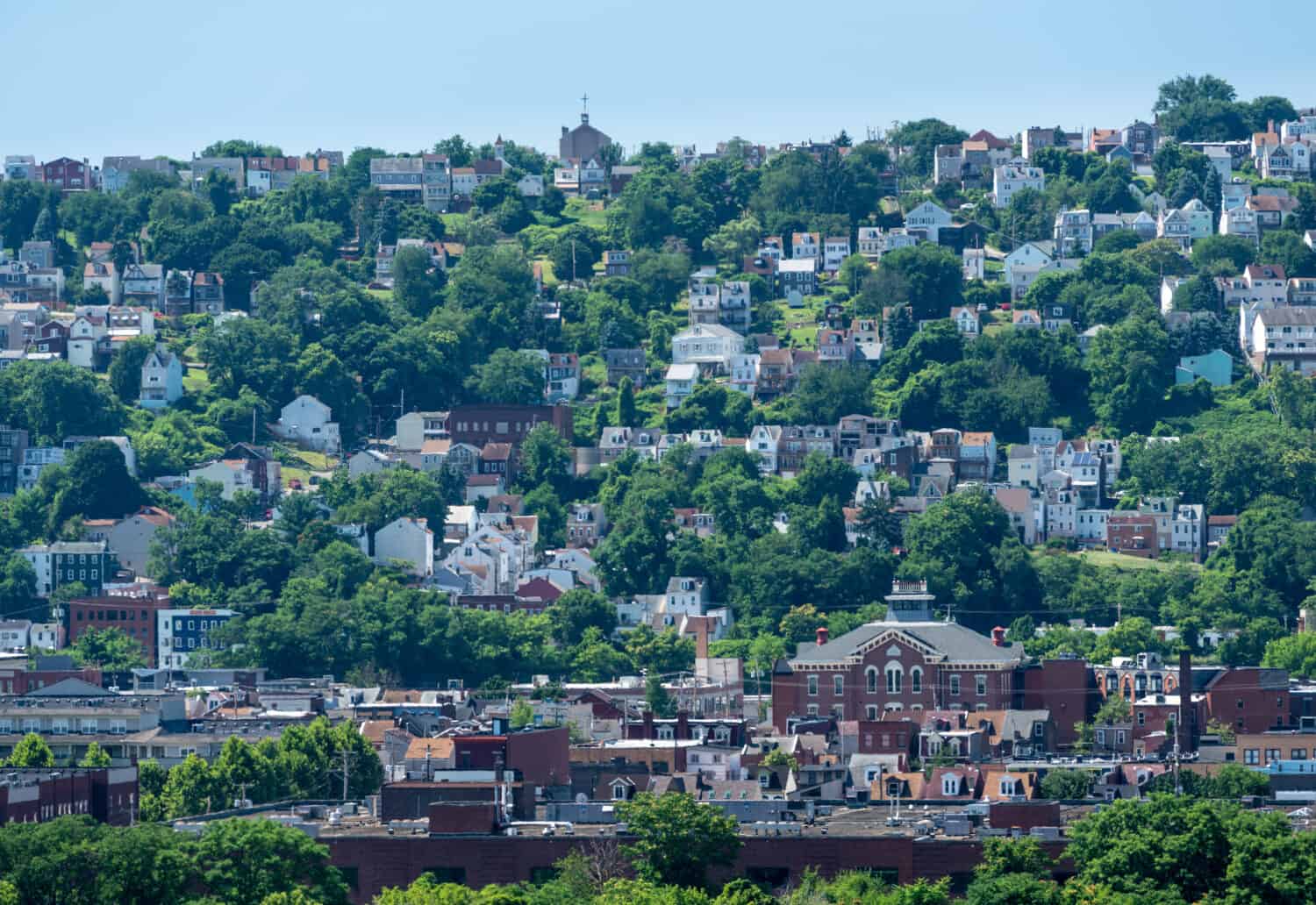
Pittsburgh’s population has recently started to increase again in recent years.
©Steve Heap/Shutterstock.com
In 2022, Pittsburgh had an estimated population of around 302,898 residents covering 58.34 square miles (151.03 square kilometers). The city has a young demographic thanks to the student population living close to Pittsburgh’s universities and colleges.
Known for its diversity, the city’s ethnic groups include European Americans, African Americans, Asian Americans, and Hispanic or Latino Americans, creating a vibrant and multicultural environment.
Beyond the city limits, the Pittsburgh Metropolitan Area, also known as Greater Pittsburgh, includes surrounding counties Allegheny, Beaver, Butler, Washington, and Westmoreland. The Metropolitan’s population is over 2.3 million.
Throughout its history, Pittsburgh experienced significant population declines during the mid-to-late 20th century, essentially due to the deterioration of the steel industry. In recent years, Pittsburgh began to attract young professionals and millennials, primarily drawn to the city’s growing tech and healthcare industries.
Discover More About Pittsburgh’s Geography
Pittsburgh is an essential economic center in Pennsylvania. Its strategic location was an advantageous gateway for westward expansion during the country’s early history, fostering trade and industry. The proximity to natural resources, including coal and iron ore, further fueled the city’s growth as a significant center for steel production during the 19th and 20th centuries.
Pittsburgh’s geography is characterized by the confluence of three major rivers: the Allegheny, Monongahela, and Ohio. Along with the “Steel City,” this unique location has earned Pittsburgh another nickname, “The City of Three Rivers.” The Allegheny River flows in from the north, the Monongahela River from the south, and their confluence forms the Ohio River, which continues westward.
Picturesque Hills and Rivers

Both inclines on the side of Mount Washinton are 146 years old.
©Sean Pavone/Shutterstock.com
Pittsburgh is nestled within a valley surrounded by picturesque hills and elevated terrain. Mount Washington and the South Hills offer breathtaking panoramic views of the city skyline and the rivers. At river level, the city’s elevation is approximately 700 feet (213 meters) and rises to over 1,300 feet (396 meters) at some of the highest points.
With its hills, the city’s topography is undulating. Some neighborhoods are perched on hilltops, others below close to the rivers. This has led to the growth of distinct communities with their own local character and charm. Because of the hilly terrain, numerous bridges and inclines have been constructed, contributing to the city’s unique infrastructure and aesthetic appeal. If you are on a visit to Pittsburgh, do not miss the opportunity of riding the funicular railways the city offers. Mount Washington has two to offer, the Duquesne and Monongahela Inclines. Get ready for a smooth and spectacular ride!
Beyond the city limits, Western Pennsylvania features lush greenery, forests, and parks. The surrounding areas provide plentiful opportunities for outdoor recreation and a break from urban life.
Pittsburgh’s geography, with its rivers and hills, has played a pivotal role in shaping the city’s history, culture, and way of life. It continues today to play a crucial role in its development and prosperity. Pittsburgh now provides residents and visitors with the perfect mix of nature’s beauty and urban living’s vibrancy.
Discover Pittsburgh Climate
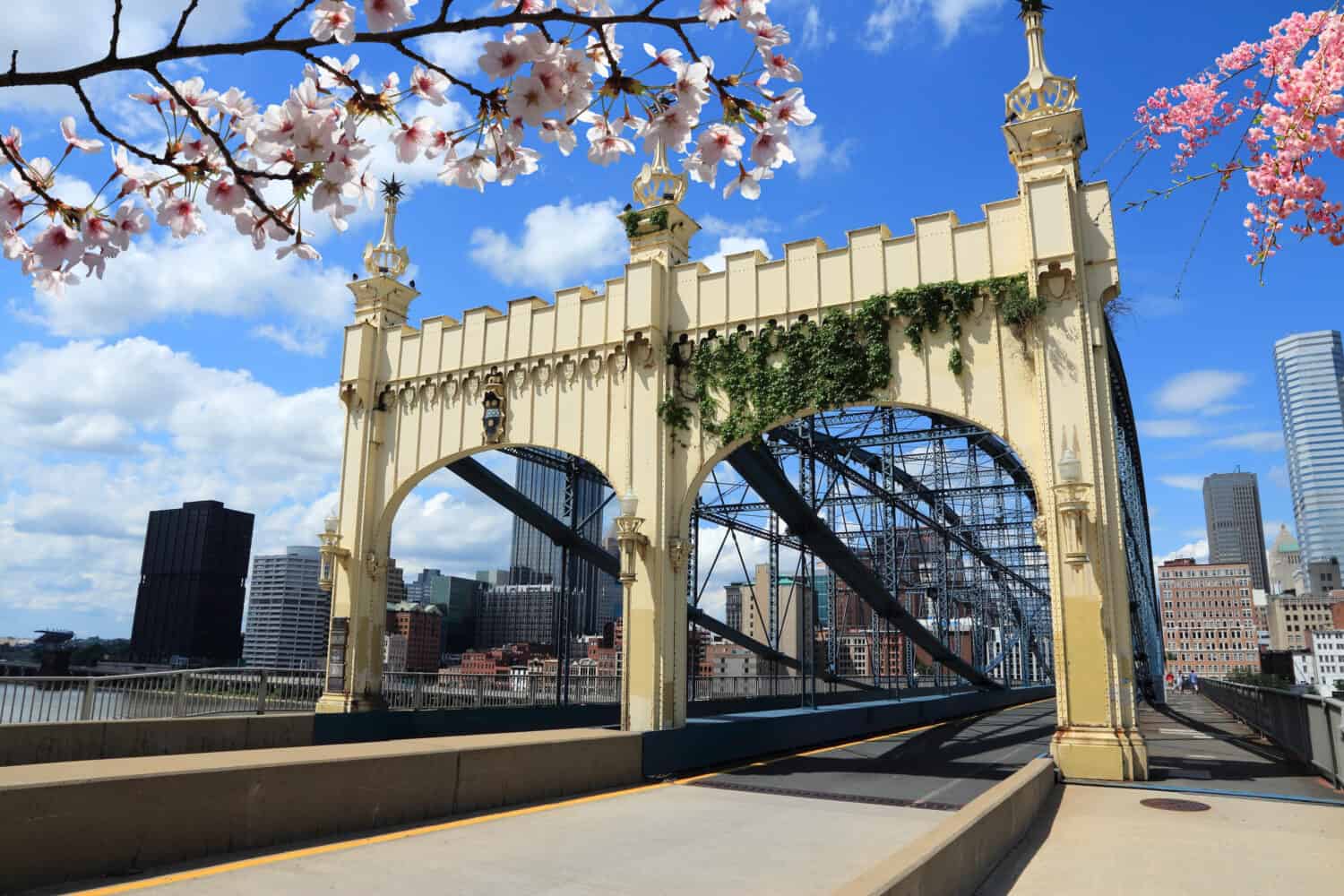
Spring in Pittsburgh has a large amount cherry blossoms and flowering trees.
©Tupungato/Shutterstock.com
Pittsburgh experiences a diverse climate with distinct weather during the four seasons. Located in the northeastern United States, winter can be cold, with occasional snowfall and temperatures dropping into the range of 30 degrees Fahrenheit, giving a festive atmosphere during Christmas. Spring transitions from cold to milder temperatures with occasional snow showers in March, followed by higher temperatures and blooming foliage in May.
Summer is warm and humid; temperatures vary, ranging from the 70s to 90s Fahrenheit. July is the warmest and the most humid, accompanied by frequent afternoon thunderstorms. Autumn features stunning foliage while temperatures cool to the 50s and 60s Fahrenheit.
Each season offers unique attractions and activities, making it a dynamic city to experience year-round.
What Is Pittsburgh Famous For?
Pittsburgh is well known for its strategic importance during early American history and its vibrant iron and steel industry.
During the French and Indian War, the British established Fort Pitt, named in honor of British Prime Minister William Pitt the Elder, at the site of modern Pittsburgh. The fort was crucial in securing the western frontier and facilitating westward expansion. In 1791, Pittsburgh was one of the most critical places for the Whiskey Rebellion.
Steel and Iron Industry
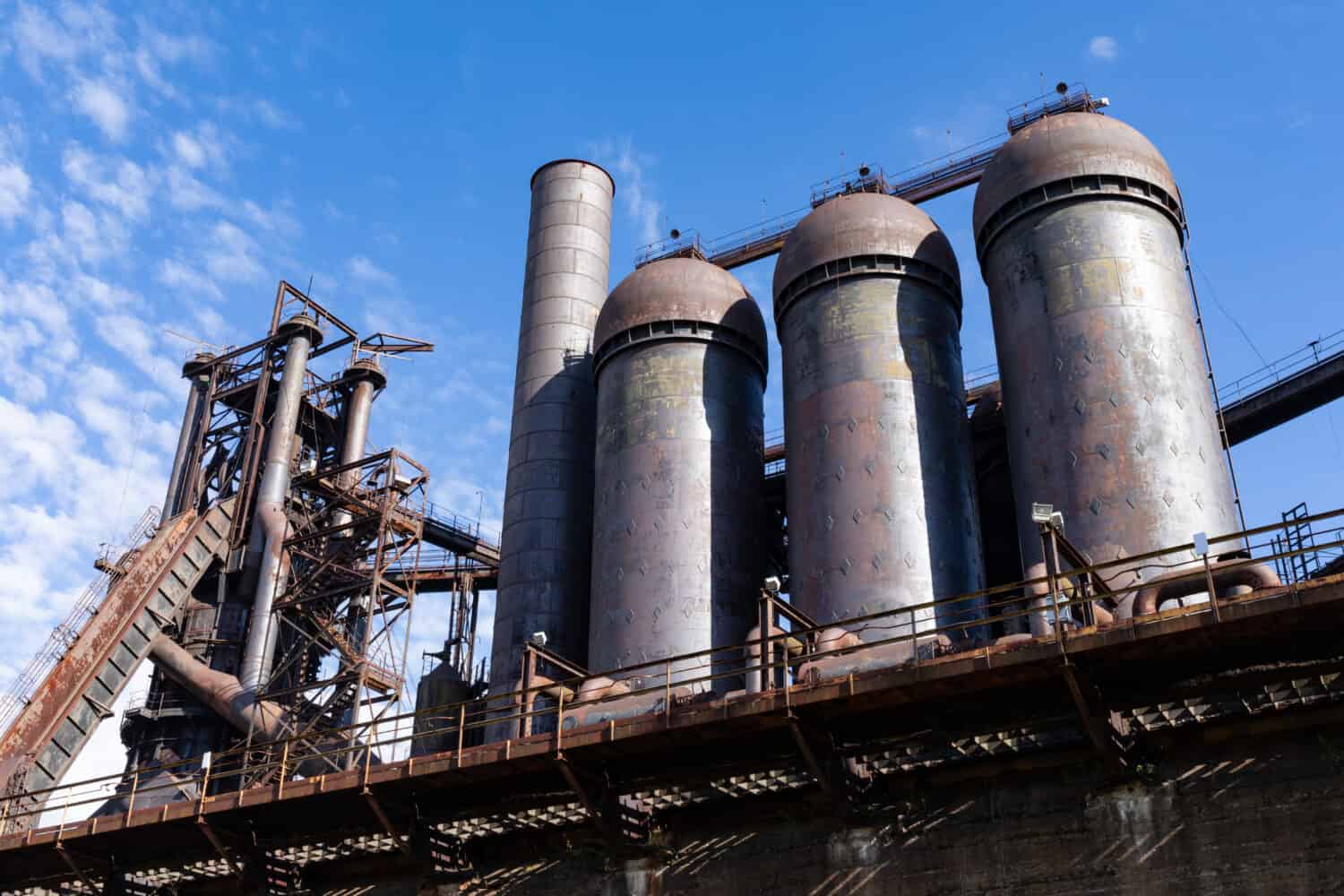
Old steel mills are still sparse in Pittsburgh.
©NatalieSchorr/Shutterstock.com
The city’s natural resources, including vast coal and iron ore deposits, laid the foundation for its emergence as a major industrial city. In the mid of the 19th century, the development of the steam engine and the Bessemer process — a revolutionary method for mass-producing steel — further fueled the industry. With its waterways available to transport people and goods, Pittsburgh became a strategic location and the perfect industrial hub.
Andrew Carnegie, a Scottish-American industrialist, played a pivotal role in Pittsburgh’s steel dominance. In the late 19th century, he built the Edgar Thomson Steel Works near Braddock, PA. It became the first steel mill in the country to operate on the Bessemer process. Carnegie then expanded his steel empire, creating the Carnegie Steel Company, which became the largest steel company in the world.
If Pittsburgh was the home of the steel industry, the city brought the most infamous labor conflict in American history: the Homestead Strike of 1892. Workers at the Homestead Steel Works, owned by Carnegie Steel, went on strike in protest of wage cuts and poor working conditions. The protests escalated with violence and deadly confrontations between striking workers and Pinkerton agents hired to protect the mill. The strike ended in defeat for the workers, but it had significant implications for labor rights and the role of unions in the United States.
In the late 19th and early 20th centuries, Pittsburgh played a crucial role in American industrialization. The city’s steel and iron output contributed to the construction of bridges, railways, and skyscrapers across the country. The steel produced in Pittsburgh was vital for constructing iconic structures like the George Washington Bridge and the Empire State Building.
Reinvention and Revitalization
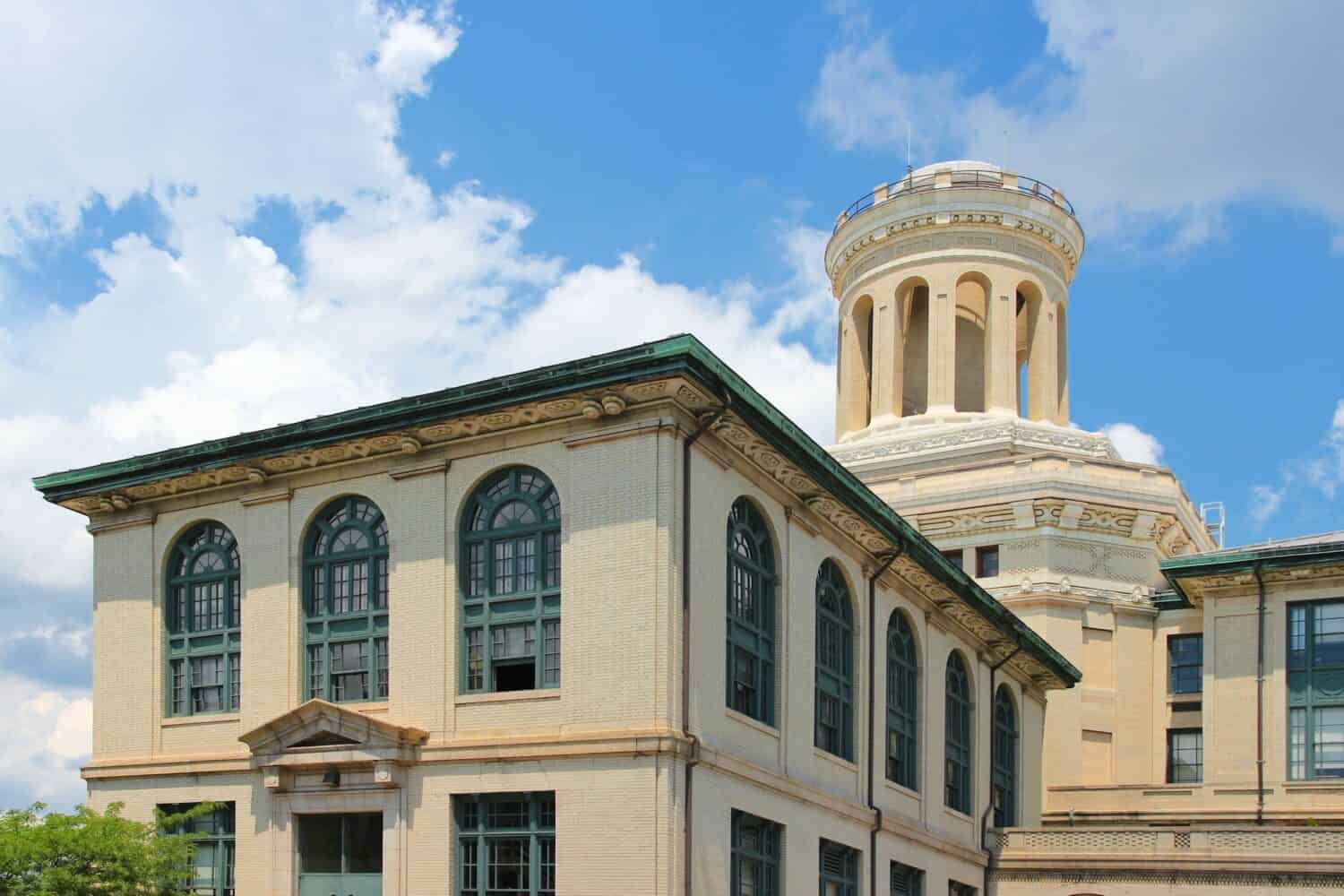
Carnegie Mellon University is at the center of technology and innovation research.
©Tupungato/Shutterstock.com
By the 1970s, increased foreign competition and technological advancements led to a decline in the domestic steel industry. Many steel mills in Pittsburgh closed, leading to economic hardship and significant population loss in the region.
Nowadays, while Pittsburgh’s steel industry has significantly diminished, its heritage as the “Steel City” still influences its identity. Once crucial to the steel industry, the rivers and bridges remain iconic landscape features.
Pittsburgh thrives on a diverse range of industries. It is a significant center for technology and innovation with numerous tech companies and startups. Also, Carnegie Mellon University— founded by Andrew Carnegie — plays a crucial role in fostering technological advancements in artificial intelligence, computer science, and robotics.
With its past as an industrial city, Pittsburgh has moved toward renewable energy. The city has invested in environmentally friendly programs such as improved public transportation and increased usage of renewable energy sources. Pittsburgh’s commitment to sustainability is recognized through efforts to rehabilitate former industrial sites into eco-friendly buildings.
With its ability to adapt and reinvent itself, Pittsburgh is a model for post-industrial urban renewal. It shows how a city can thrive by embracing innovation while honoring its industrial past.
Is Pittsburgh a Good Place to Live?
With its rivers, parks, hills, and lush surrounding areas, Pittsburgh is a great city to live in. In addition, it offers vibrant sports, culture, arts, and food specialties.
Cheer on the Local Sports
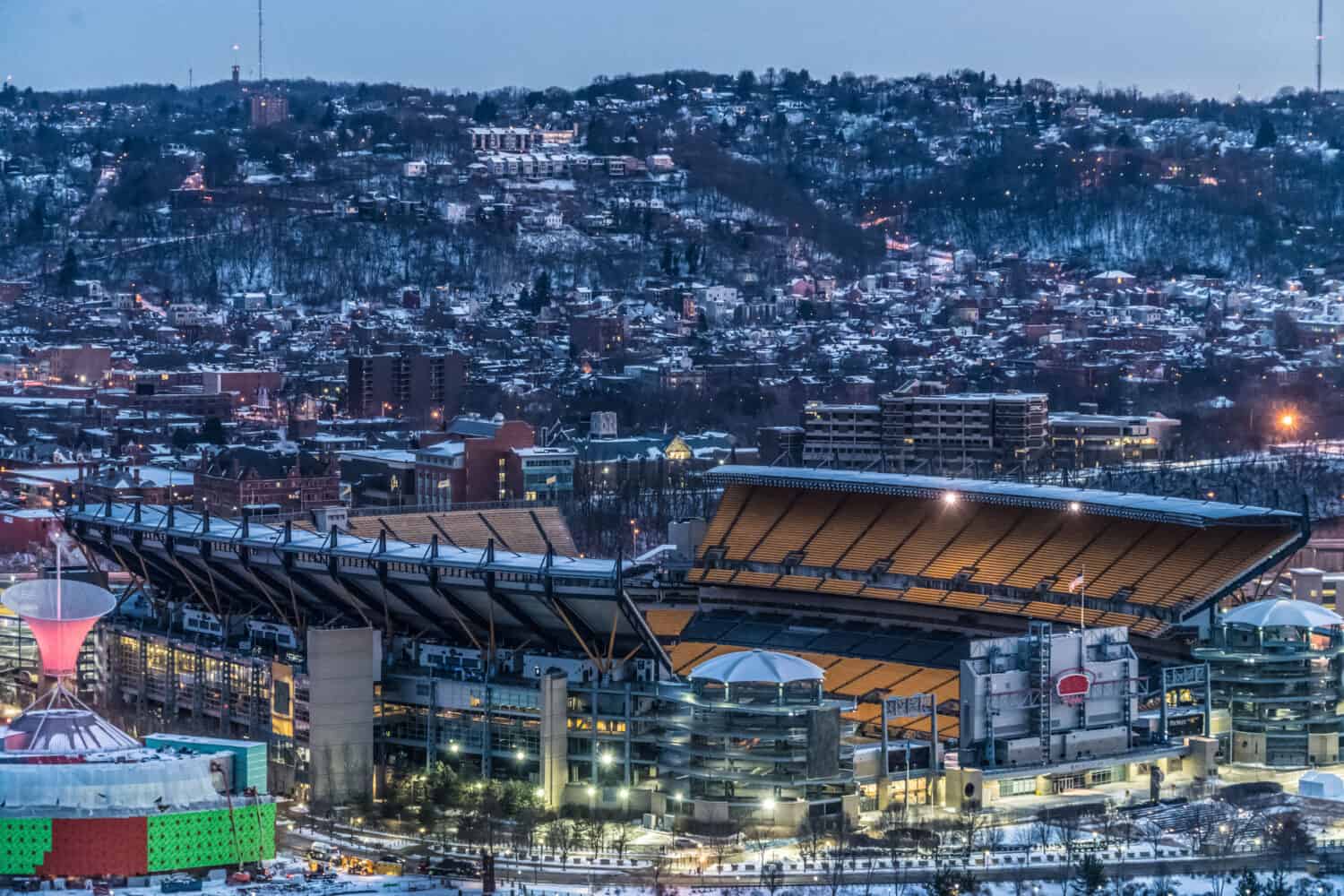
Acrisure Stadium, home of the Steelers, can host more than 68,000 fans.
©Jason Sponseller/Shutterstock.com
Haven for sports enthusiasts, the city is home to three iconic teams: the Pittsburgh Steelers (NFL), Pittsburgh Penguins (NHL), and Pittsburgh Pirates (MLB). And these teams left their mark in their respective sports. The Steelers won six Super Bowls, the last one in 2008. The Penguins won five Stanley Cups, while the Pirates five World Series titles.
In addition, the Pirates play at PNC Park, often ranked as one of the most beautiful baseball stadiums in the United States.
And aside from these American favorites, the city welcomes three other professional sports teams: the Riverhounds in soccer, the Passion for a full-contact women’s football team, and the Thunderbirds, an Ultimate Frisbee franchise.
The deep passion for sports in the community creates a lively and spirited atmosphere during game days. Whether cheering at Acrisure Stadium for the Steelers or supporting the Penguins at PPG Paints Arena, Pittsburgh’s sports culture offers plenty of opportunities for fans to engage in the sports scene.
Cultural and Arts Scene

Andy Warhol was born in Pittsburgh in 1928.
©Helene Gaillet/Shutterstock.com
Pittsburgh’s cultural scene is vibrant and diverse. The wide variety of museums, theaters, and art galleries offers an almost endless to residents and visitors.
If you enjoy Andy Warhol’s visual work, Pittsburgh is a must-destination. The Andy Warhol Museum showcases his life and iconic pieces. It is also the largest museum in the United States dedicated to a single artist.
Also, the city boasts the Carnegie Museums of Art and Natural History, where visitors can explore impressive art collections and fascinating exhibits on natural history.
On the musical scene, the Pittsburgh Symphony Orchestra and Pittsburgh Ballet Theatre contribute to the city’s rich musical and performing arts scene with various shows and representations. Annually, the Three Rivers Arts Festival — named after the rivers flowing into the city — is held downtown. The festival showcases local and international artists and attracts art enthusiasts from around and outside Pennsylvania.
Eat like Pittsburgh Locals!
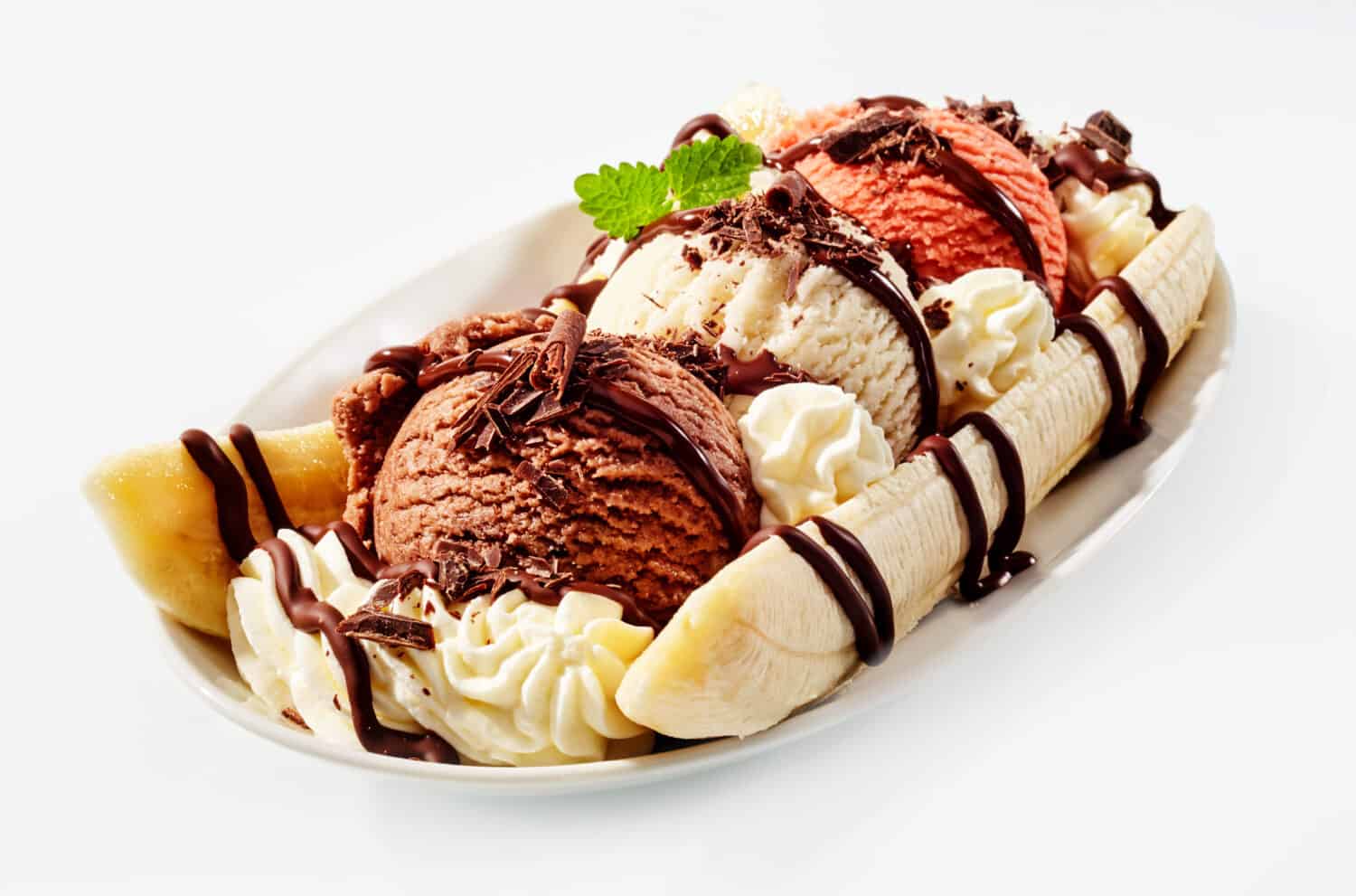
The banana split is a classic dessert from Pennsylvania.
©stockcreations/Shutterstock.com
Pittsburgh is known for its unique food specialties that reflect its diversity and working-class heritage.
If you visit Pittsburgh, do not miss the famous culinary delight, the “Primanti Brothers Sandwich.” This sandwich is filled with grilled meat, coleslaw, and French fries, served between two thick slices of Italian bread. It has become an iconic symbol of Pittsburgh’s food culture and a visitor must-try.
But this is only one of the multiple foods to try. Known for its Polish dishes and fried fish sandwiches, the possibilities are endless. Remember to try these foods on your trip.
- Pierogies: Originally from Poland, these dumplings are filled with mashed potatoes, cheese, sauerkraut, or meat and are typically served with butter or sour cream.
- Chipped Ham Sandwich: A local favorite, with thinly sliced deli ham piled high on a soft bun, often served with lettuce, tomato, and mayonnaise.
- Fish Sandwich: These local sandwiches feature a generous portion of fried fish fillet, lettuce, and tartar sauce.
- City Chicken: Consists of pork and/or veal cubes, skewered and coated in breadcrumbs before being baked or fried.
- Haluski: Another Polish dish, haluski is a comfort food made from egg noodles, cabbage, and sometimes bacon or sausage, all sautéed together.
- Banana Split: Invented in nearby Latrobe, PA, Pittsburgh has embraced the banana split as its own.
- Kielbasa: Also from Poland, this sausage is often served at events and gatherings.
- Klondike Bar: This famous ice cream treat was invented in Pittsburgh.
Lower Cost of Living

The city of Pittsburgh has 90 distinct neighborhoods.
©Sean Pavone/Shutterstock.com
Beyond its sports, culture, arts, and culinary delights, Pittsburgh offers a relatively affordable cost of living compared to major cities in the United States.
The city has undergone significant revitalization efforts over the years, transforming former industrial sites into vibrant neighborhoods. Pittsburgh’s housing market provides diverse, affordable, and more costly urban and suburban living options. The city is known for its welcoming, friendly atmosphere and a strong sense of community among its residents. With its thriving forests, flowing rivers, numerous parks, and green spaces, Pittsburgh provides ample opportunities for outdoor activities. All of it contributes to a high quality of life.
Whether you are a potential new resident or just a visitor to the “Steel City,” you will find endless activities, food, and great neighborhoods to live in or swing by for a visit.
Thank you for reading! Have some feedback for us? Contact the AZ Animals editorial team.

